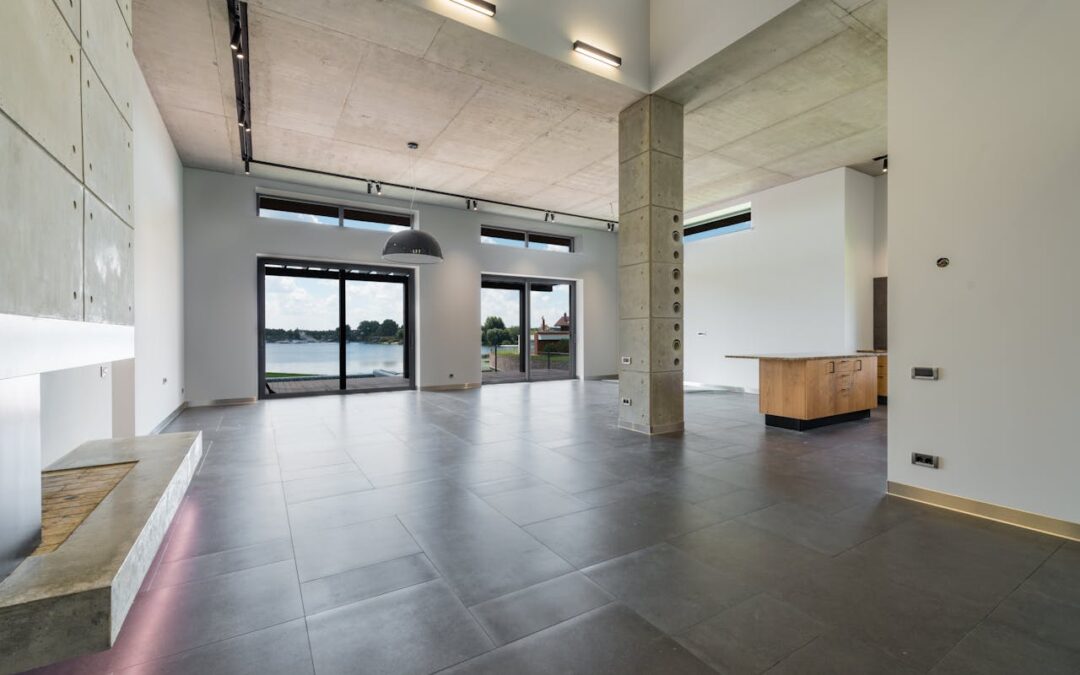Uneven concrete floors can be more than just an eyesore; they can cause tripping hazards and make it difficult to install flooring properly. Whether it’s a basement, garage, or patio, leveling uneven concrete is an important task to ensure the safety and functionality of a space. Recognizing the signs of an uneven floor is the first step in addressing the issue.
Fortunately, there are straightforward methods to tackle this task. With the right tools and preparations, many uneven floors can be fixed with a little DIY effort. Understanding when professional help is necessary is also crucial to achieving the best results. Proper floor leveling not only makes your space safer but also enhances its overall appearance and usability.
Identifying Uneven Concrete Floors
Spotting an uneven concrete floor early can prevent further complications. Common signs include noticeable slopes or dips in the floor when you walk across it. If water spills and pools in certain areas, that’s another indicator. Also, check for doors that don’t swing freely or require effort to close. These can signal shifts in the floor beneath them.
Several factors contribute to unevenness. Poor installation practices might leave the floor weak from the start. Over time, the natural settling of soil beneath concrete can lead to dips or bulges. Heavy traffic or exposure to elements may cause wear, accelerating unevenness.
Ignoring these signs can lead to significant problems. Uneven floors pose tripping hazards, which can be dangerous, especially for children and older adults. Besides safety concerns, they may interfere with future flooring projects, making installations uneven or compromising them altogether. Addressing these issues promptly saves you time and expense in the long run.
Preparing for Concrete Leveling
Proper preparation is crucial to leveling a concrete floor successfully. Gathering the right tools and materials makes the task easier and more efficient. Start with a level, a broom or vacuum for cleaning, a bucket for mixing, and a trowel or squeegee. Make sure to have floor patch compounds or a self-leveling mix ready.
Begin by thoroughly cleaning the area. Remove all debris and dust that might affect the leveling process. Any loose paint or wax needs to be scraped off. This ensures the leveling compound adheres properly to the surface. Use a level to identify high and low spots on the floor, marking them with chalk for easy reference.
Safety is always a priority during preparation. Wear protective gear like gloves and goggles to protect yourself from dust and chemicals. Ventilate the space well to avoid inhaling harmful fumes. If using power tools, make sure cords are well-positioned to prevent tripping. Taking these precautions helps create a safer working environment and sets the stage for a successful project.
DIY Concrete Leveling Techniques
Leveling concrete floors can be a manageable DIY task if handled carefully. One effective method is using a self-leveling compound. Start by mixing the compound according to package instructions until it’s smooth and lump-free. Pour it over the marked low areas. Use a trowel or squeegee to spread it evenly. The compound flows into dips, creating a flat surface as it dries.
For high spots, grinding is an effective solution. A concrete grinder works well to sand down these areas. Always use steady, circular motions to maintain evenness. This tool can be loud, so wear protective ear gear in addition to goggles and a dust mask to stay safe.
Filling low spots and minor cracks is another practical technique. Begin by cleaning the cracks thoroughly to remove any debris. Fill the cracks with a repair filler or patching compound. Smooth it out with a trowel, ensuring the patched area is level with the surrounding surface. These straightforward techniques can transform an uneven floor into a smooth, safe surface, ready for any flooring finish.
When to Call in the Professionals
Sometimes, floor leveling may require expert attention. Recognizing complex leveling issues early is vital. If cracks are large or you notice significant dips and heaves, these could be signs of underlying structural problems. Also, if the concrete is old and severely damaged, a professional might be needed to assess the situation accurately.
Professional leveling services offer several benefits. They come equipped with specialized tools and a wealth of experience, ensuring precise results. Experts can also identify problems that might not be visible to an untrained eye, like deep-set shifting that could affect the building’s structure.
Ensuring long-lasting and safe results is where professionals excel. They can guide you on the best methods suitable for your specific situation and guarantee their work, providing peace of mind. If you’re overwhelmed by the project’s complexity, seeking professional help is always a wise choice.
Conclusion
Leveling your concrete floors is an essential task that can improve safety and the overall look of your space. Whether you choose to tackle it yourself or call in experts, addressing uneven floors promptly is crucial. This proactive approach helps preserve your home’s structural integrity and maintains a safe environment for everyone.
By recognizing signs early and understanding when to seek help, you can ensure your concrete surfaces are durable and attractive. Focusing on preparation and using the right techniques can make a big difference in achieving the best results. Maintaining smooth, level surfaces boosts both functionality and aesthetic appeal.
If you’re facing a concrete leveling project that’s too challenging or simply need expert advice, consider reaching out to Lift-Texas Construction. Our team provides top-notch foundation and leveling services, lifting your home’s quality to new heights. Get in touch today for reliable solutions tailored to your specific needs!

